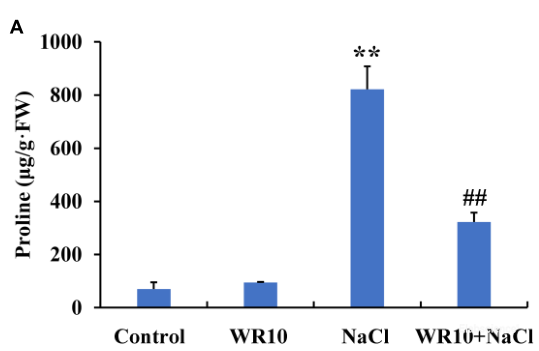Proline (Pro) Colorimetric Assay Kit
SKU: E-BC-K177-S-100
Proline (Pro) Colorimetric Assay Kit
| SKU # | E-BC-K177-S |
| Detection Instrument | Spectrophotometer (520 nm) |
| Detection method | Colorimetric method |
Product Details
Properties
| Synonyms | Pro |
| Sample Type | Plant tissue, honey |
| Sensitivity | 0.17 μg/mL |
| Detection Range | 0.17-35 μg/mL |
| Detection Method | Colorimetric method |
| Assay type | Quantitative |
| Assay time |
80 min |
| Precision | Average inter-assay CV: 5.400% | Average intra-assay CV: 4.500% |
| Other instruments required | Water bath, Micropipettor, Vortex mixer, Balance, Centrifuge |
| Other reagents required | Acetic acid, Methylbenzene, Absolute ethyl alcohol |
| Storage | 2-8℃ |
| Valid period | 12 months |
Images
ZH Yue et al investigate the function of Bacillus altitudinis for improving salt tolerance in wheat. Proline (Pro) level in wheat tissue was determined using Proline colorimetric assay kit (E-BC-K177-S).

The levels of proline concentration was significantly increased with salt tolerance and reversed by WR10. (**P<0.01 vs Control, ##P<0.01 vs NaCl)
Dilution of Sample
It is recommended to take 2~3 samples with expected large difference to do pre-experiment before formal experiment and dilute the sample according to the result of the pre-experiment and the detection range (0.17-35 μg/mL).
The recommended dilution factor for different samples is as follows (for reference only):
| Sample type | Dilution factor |
| Green pepper tissue homogenization | 1 |
| Carrot tissue homogenization | 1 |
| Epipremnum aureum tissue homogenization | 1 |
| Lettuce leaf tissue homogenization | 1 |
| Honey | 1 |
| Cabbages tissue homogenization | 1 |
Note: The diluent is Reagent 1.
Detection Principle
Proline can react with acidic-ninhydrin to form stable red compound. The maximum absorption peak of the compound is at 520 nm. And the concentration of Pro can be calculated by measuring the OD value at 520 nm.

Kit Components & Storage
| Item | Component |
Size 1 (50 Assays) |
Size 2 (100 Assays) |
Storage |
| Reagent 1 | Extracting Solution | 50 mL× 3 vials | 60 mL× 5 vials | 2-8°C, 12 months, shading light |
| Reagent 2 | Ninhydrin | 3 g × 1 vial | 6 g × 1 vial | 2-8°C, 12 months, shading light |
| Reagent 3 | Acid Reagent | 50 mL× 1 vial | 50 mL× 2 vials | 2-8°C, 12 months |
| Reagent 4 | 100 μg/mL Proline Standard |
1 mL× 1 vial | 2 mL× 1 vial | 2-8°C, 12 months, shading light |
Note: The reagents must be stored strictly according to the preservation conditions in the above table. The reagents in different kits cannot be mixed with each other. For a small volume of reagents, please centrifuge before use, so as not to obtain sufficient amount of reagents.
Technical Data:
Parameter:
Intra-assay Precision
Three honey samples were assayed in replicates of 20 to determine precision within an assay. (CV = Coefficient of Variation)
| Parameters | Sample 1 | Sample 2 | Sample 3 |
| Mean (μg/mL) | 2.80 | 16.40 | 28.50 |
| %CV | 4.7 | 4.4 | 4.4 |
Inter-assay Precision
Three honey samples were assayed 20 times in duplicate by three operators to determine precision between assays.
| Parameters | Sample 1 | Sample 2 | Sample 3 |
| Mean (μg/mL) | 2.80 | 16.40 | 28.50 |
| %CV | 5.1 | 5.8 | 5.3 |
Recovery
Take three samples of high concentration, middle concentration and low concentration to test the samples of each concentration for 6 times parallelly to get the average recovery rate of 105%.
| Standard 1 | Standard 2 | Standard 3 | |
| Expected Conc. (μg/mL) | 6.5 | 18 | 27.6 |
| Observed Conc. (μg/mL) | 6.9 | 18.5 | 29.3 |
| Recovery rate (%) | 106 | 103 | 106 |
Sensitivity
The analytical sensitivity of the assay is 0.17 μg/mL. This was determined by adding two standard deviations to the mean O.D. obtained when the zero standard was assayed 20 times, and calculating the corresponding concentration.
Standard Curve
As the OD value of the standard curve may vary according to the conditions of the actual assay performance (e.g. operator, pipetting technique or temperature effects), so the standard curve and data are provided as below for reference only.
| Concentration (μg/L) | 0 | 5 | 10 | 15 | 20 | 30 | 35 |
| Average OD | 0.003 | 0.152 | 0.330 | 0.487 | 0.675 | 1.008 | 1.203 |
| Absoluted OD | 0 | 0.149 | 0.327 | 0.484 | 0.672 | 1.005 | 1.200 |



